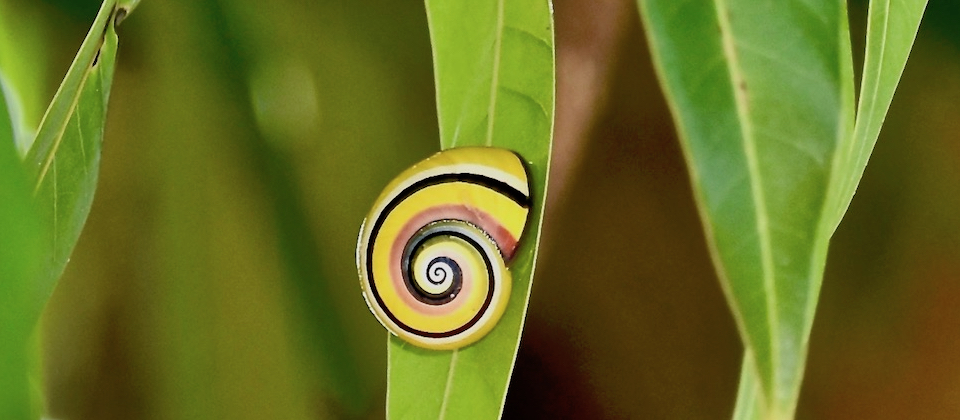
Published on 6 March, 2021.
Dedicated to all naturalists out there – no matter if you’re a scientific researcher or just a wildlife enthusiast, a super seasoned explorer or a loving parent of kids starting to open their eyes to the wonders of this world!

In previous posts, we’ve shared with you the beauty of birds in the Baracoa region, the strange and delicate orchids that surround us in this area of Eastern Cuba, the rough and enigmatic appeal of our karstic landscapes. And we’ll bring you soon the variety of fungi and ferns that thrive in our tropical rainforests – but there’s way more in Baracoa to captivate your senses and your soul…
Tiny beings that offer you a huge thrill
This post brings you a hint of the charm of the myriad little critters that inhabit Baracoa and surrounding regions – fluttering butterflies, translucid dragon flies, colourful tree snails and cool geckos and frogs! They’re all part of the experience you can live in Baracoa’s amazing mountainous landscapes and conspicuous water streams while you breathe the freshest air you can wish for…

Where shall we start? Let us begin with tree snails. Most probably they’re not the type of fauna that would come to your mind if they asked you to name beautiful animal species, but just take a hike in Baracoa and… lo and behold! Uniquely Eastern Cuban gems, to be found exclusively in our region and surrounding areas!
The habitat of the world-famous Polymita tree snails
Let’s say it right away. Polymita tree snails are endangered and need everyone’s protection. Baracoa invites you to get acquainted with these beauties and enjoy them from up close. But you’re also warmly asked to join in as an active partner in conservation efforts: please reject any offers from unscrupulous sellers of the living animals or the shells.

The Polymita genus is endemic to Cuba’s far east. Most of the Polymita tree snails you will see in Baracoa and surrounding areas are of the picta species – and you’ll discover various subspecies too! All of them live on trees, including wild tree species as well as fruit or coffee trees.
Mind you, they are great friends of the flora they inhabit, as they feed on the thin layer of fungi that cover leaves, thus allowing for the leaves’ breathing and photosynthesis to happen.
Let’s begin with two subspecies: Polymita picta roseolimbata and nigrolimbata
At the Yumuri Canyon, you will mostly see Polymita picta roseolimbata. The name refers to the pale rosaceous colour of their spiral’s innermost line (the “sutural band”), where one turn of the spire meets the next. Check them out!

But the canyon is also a great place to discover the mesmerizing Polymita picta nigrolimbata with their neat black innermost spiral line.
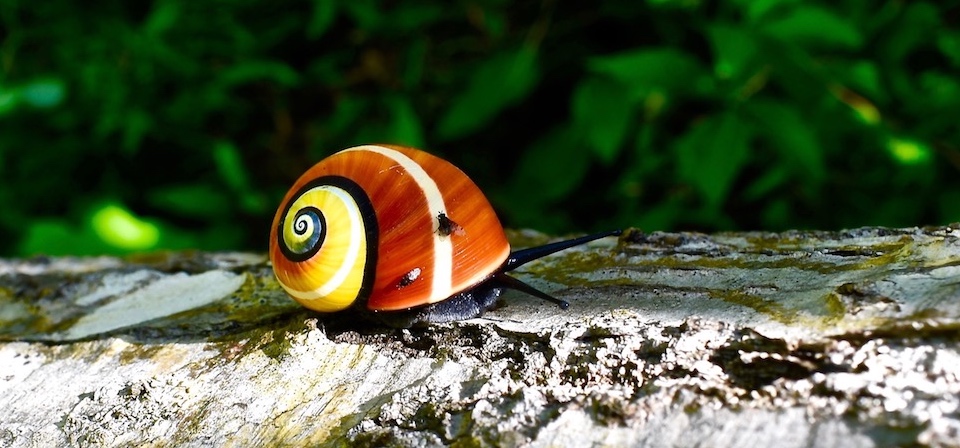
Two more subspecies: Polymita picta picta and Polymita picta fuscolimbata
The nominal subspecies is Polymita picta picta. You’ll recognize it for its dark, discontinuous inner spiral line and because, as their shell grows, the dark line bordering the shell’s opening which indicated each previous stage of growth, remains visible. These two were seen on the trail leading to mount El Yunque’s summit.


Meet Polymita picta fuscolimbata. It’s recognized by its rusty, rufous-to-brown inner spiral line which sort of “bleeds” a bit over the shell’s spire. These two are from the Yara-Majayara Protected Area and Alexander Humboldt National Park, respectively.


This albino fuscolimbata stood out with its creamy colour during a stop we made on La Farola road, near the Alto the Cotilla panoramic lookout.

But the most eye-catching fuscolimbata are found in the newly created Tetas de Santa Teresa Protected Area, very near the entrance to Baracoa. Look at how deep the burnt rufous colour of the inner spiral line is – and how it does bleed more widely across the shell!
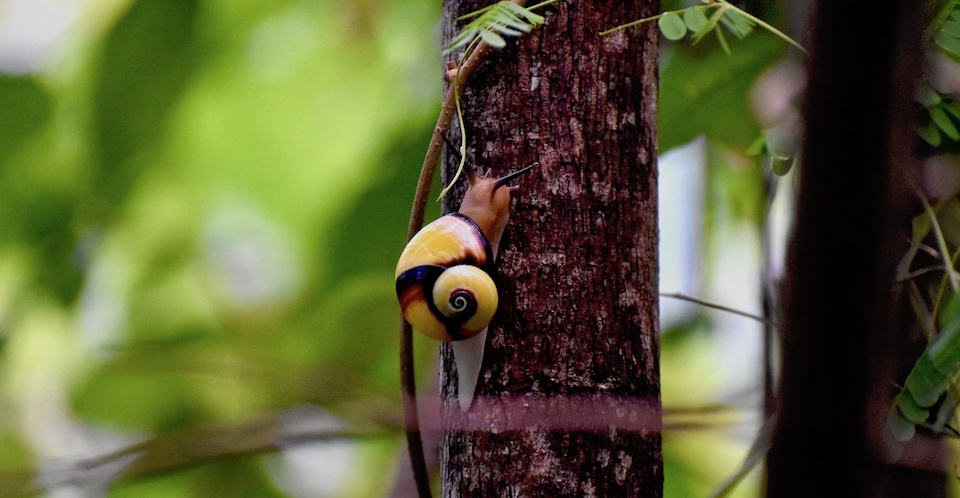

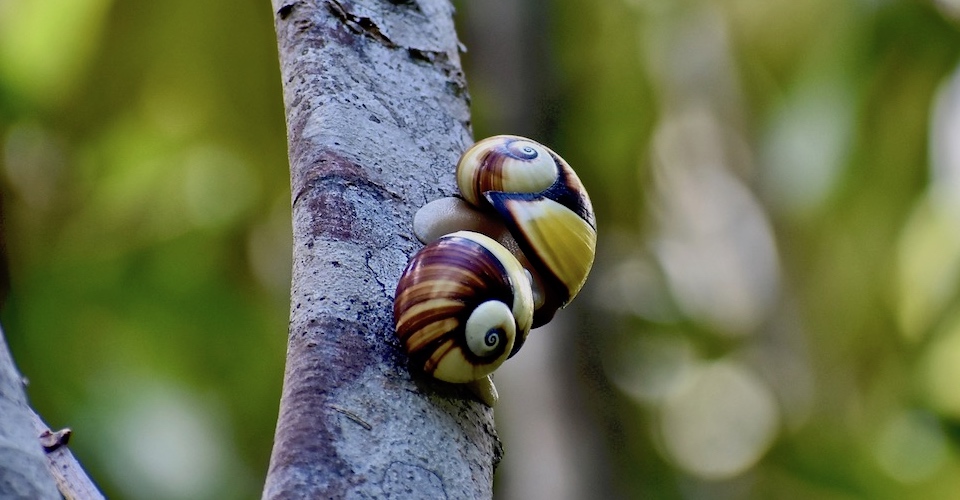
And two more: Polymita picta iolimbata and Polymita versicolor
Another spectacularly coloured subspecies is Polymita picta iolimbata. Its name honours the deep iodine tones of their shiny, varnished-like shells. In order to see this subspecies (and the species coming up below), we recommend a guided tour along Maisí’s southern coast with an environment protection specialist.



Last but not least, another Polymita species (not a subspecies of the picta, but a separate species on its own) – the Polymita versicolor. This beauty has its specific habitat and location in dry, spiny flora coastal environments and, as we mentioned, requires a specialized environment protection specialist to see it too.



Shall we switch from tree-snails to butterflies?
Baracoa and Cuba’s easternmost tip: Butterflies galore!
Who doesn’t love butterflies! Cuba is home to over 200 species of the fluttery creatures. About 35 of those species or subspecies are endemic to our country. Here we share with you a small selection of those you can find when you explore our region.
To start, a lovely Tropical Buckeye (Junonia zonalis).

This is a Banded Yellow or Eurema elathea elathea. It lives in the Greater Antilles, the Bahamas and the Cayman Islands – in Cuba it’s more common in the eastern part of the island.

Next up: a Dina Yellow or Pyrisitia dina dina. While Pyrisitia butterflies can be found all over the continent, the subspecies dina is endemic to Cuba.

Some commonly found bright orange beauties
The spotted Antillean Crescent has a subspecies that is endemic to our country – Antillea pelops anacaona. You will see it at the edge of bushes, dirt roads and trails.

This one here is a Gulf Fritillary (Agraulis vanillae). A very common and pretty species, endemic to the Greater Antilles and the Bahamas and lovely to be seen either with its wings open or closed.


The next butterfly is called Julia or Flambeau (Dryas iulia). The subspecies nudeola is endemic to Cuba – and abundant in our garden. The one pictured here is a beautiful female.

Open-wings versus closed-wings posers
You will find the White Peacock to be a treat to observe and photograph – it is abundant, and it stands on flowers with its wings wide open. The subspecies you’ll find in Cuba is Anartia jatrophae guantanamo (which is also present in the southern U.S. and the Bahamas).

Next up is the Zebra Longwing (Heliconius charithonia ramsdeni), which can be seen both with open and closed wings. This subspecies lives in Cuba and certain Bahamas islands. We have several individuals living in our garden, surely because of the shade and our Passifloraceae vines where they lay eggs and you can see larvae.


This one is a Two-spotted Prepona (Archaeoprepona demophoon). The subspecies crassina is endemic to Cuba, it lives in forests and sits high on trees. It has beautiful deep blue bands but it’s not easy to photograph with open wings!

Orion Cecropian is the largest butterfly living in Cuba. You’ll often see it as it appears on our picture: on a tree trunk, wings closed, facing down – or on very ripe fruit. This subspecies (Historis odius odius) lives in the Greater Antilles.
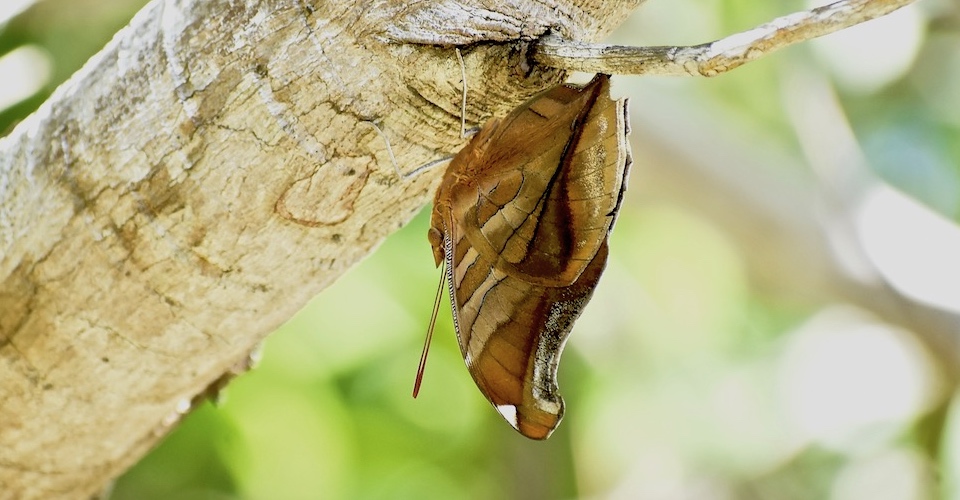
Be ready for the sudden burst of a skipper!
You will come across some really bright sparks of blue, like this Mangrove Skipper (Phocides pigmalion batabano). Other than in some of the Bahamas islands and the Cayman Islands, this subspecies is widely distributed in Cuba, where it tends to live close to the coast.

Here’s another splashy blue skipper that’s hard to miss – its name says it all: an Antillean Flasher! In Cuba you will find the endemic subspecies Telegonus xagua xagua.

Now, here are some Cuban specialties – a few endemic butterflies
The Calisto butterfly, with its 17 subspecies, can only be seen in Cuba. The subspecies shown here – Calisto dissimulatum– is found exclusively in Eastern Cuba, mostly in mountainous areas. We saw this one in the charrascal flora areas of river Las Minas.

Next up is a Cuban Checkerspot or Atlantea perezi, a rare Cuban endemic located in Eastern Cuba, mostly in the mountains of Moa and Baracoa. We took this picture near the summit of the iconic mount El Yunque. From the conservation perspective, it is considered to be vulnerable.

We’ll close this section about butterflies with two flashy endemic swallowtails. The first one is a Cuban King Swallowtail (Heraclides oviedo). We show you here a picture taken in our garden at Villa Paradiso and another one after the rain in the serpentine rock mountains around Quibiján. Notice how beautifully creamy its underside is!


And last but not least, the most iconic endemic butterfly of Cuba, Gundlach’s Swallowtail (Parides gundlachinaus)! Named after Johannes Gundlach, the great 19th-century naturalist passionately dedicated to Cuban wildlife, this beauty lives in the far west and the far east of the island, being more frequently found in the latter. We took the first picture on the trail that leads to the wonderful Pozo Azul sinkhole and the second one in the evergreen flora on karst at Yara-Majayara Protected Area.


The most up-to-date, comprehensive sources about butterflies in Cuba
One of the best sources of information about Cuban butterflies is, without a doubt, Tim Norriss’ superbly curated website, Butterflies of Cuba. We are grateful to Tim for his generous help in identifying species and for having shared with us great info on various species as well. Do check out the rich picture gallery and species information on his website prior to your trip to Cuba!
We also strongly recommend the newly released field guide Mariposas de Cuba, Guía de Campo (2020), edited by Carlos A. Mancina et al. Available in PDF format, it includes great pictures to help you identify your sightings as well as maps for each butterfly species’ distribution in Cuba.
Interlude – Cuban dragonflies!
So, you’re out in the wild and enjoying all sorts of little critters. You can be sure that dragonflies will be there too – and they come in all colours!




We love this delicate one with its protruding, cartoon-like eyes and short antennae!

Time to discover Cuban lizards and geckos in all shapes and colours
From home gardens to farmlands to forests, lizards and geckos will pop up at you. Shall we start with the slim and long ones? This one here is an Anolis inexpectatus that we met at Alexander Humboldt National Park.

A similarly thin and long one but with a black patch from the eye to the cheek and the shoulder is this Anolis anfiloquioi.

You cannot see its tail on this photo, but this Anolis argenteolus is also quite long. It was hanging out, very cool, at the top of the karst in the newly created Tetas de Santa Teresa Protected Area, just outside of town.

A very common lizard across Cuba is the apple-green coloured Anolis porcatus. This is a male – check out the bright red with white spots on the gular fold, that it displays for courtship or territorial purposes!
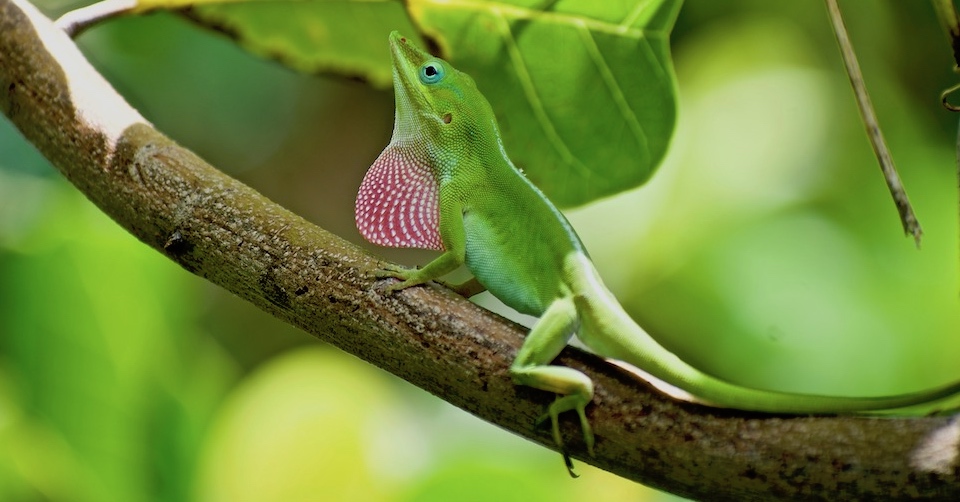
Anolis rubribarbus also has a flashy, bright orange gular fold – but we haven’t been able to get a pic of it!

This yellow-green beauty is an Anolis allogus.

And this other one here is an Anolis sagrei.

Check out Leiochephalus macropus‘ colourful (creamy yellow, blue-green) dots on its flanks – and its curly tail.

You’ll see Pholidoscelis auberi suddenly making itself noticed as it swiftly flees with its electric blue hues!
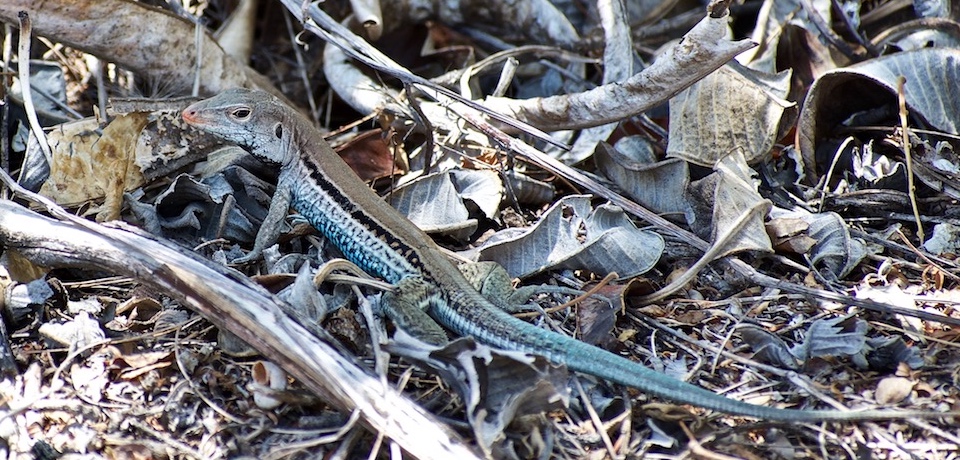
Not so little critters, but certainly not to be missed!
At some 15 cm from snout to vent and around 45 cm total length, the Anolis baracoae is one of the most popular endemic stars of our region’s fauna. It can be distinguished from other green anoles of similar size by the orange dots matched by black dots on its shoulder crease. Sometimes, you’ll see such orange-and-black spots splatter the whole torso… We’re so fond of this species we thought we’d offer you three different pics!


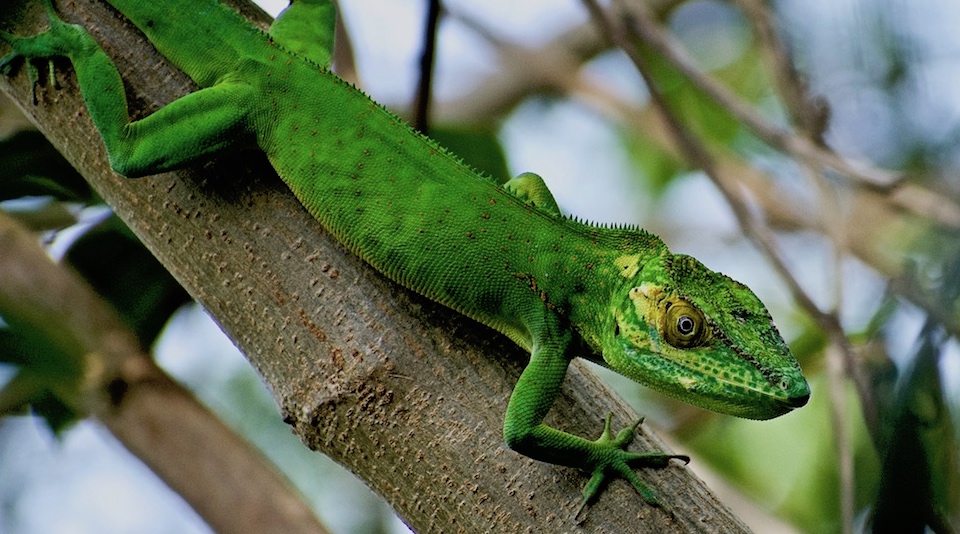
We couldn’t believe our eyes when we bumped into this love-making couple on Guantánamo’s southern coast. It’s the beautiful Anolis smallwoodi, another endemic of Cuba’s far, far east. We’re proud to tell you that our photo has been requested by Cuban experts wishing to publish it on a couple of different upcoming books on Cuba’s natural wonders! (Of course, we obliged!)

Now – behold the (even less little) Cuban Iguana (Cyclura nubila). An eternal favourite of visitors, this is also an endemic beauty (so to speak)! Yes, you can see it in our closest protected area, the wonderful Yara-Majayara!


An amazing show-stopper – one of the tiniest frogs in the world!
Kids – you need to come to Alexander Humboldt National Park to see this tiny wonder. At no more than 9.8 mm-long, the Iberia Frog (Eleutherodactylus iberia) is the most charming little thing you can find in Baracoa! Needless to say, it is another Cuban endemic – and it can only be found in our region.

We would like to warmly thank Italian photographer Paolo Vimercati for his kind permission to use his awesome photo of the Iberia Frog for this post. We’ll have you know that Paolo is a great tour leader who offers organized photography-focused tours in and around Baracoa.
Conservation – a great pride for Baracoans and travellers alike
Talking about conservation of vulnerable critters… A couple of guests who stayed with us some time ago shed the best light on this matter, telling us that “nothing compares with the moment of seeing Polymita tree snails alive, thriving in their own environment. Pictures are always a great and unique souvenir you can show off – there is no point in fetishizing their shells! After all, who would ever like to play the infamous role of an eco-predator?”
(May we add – you could also get a solid fine at airport customs and be charged with criminal activity if you’re caught trying to smuggle protected species).
A highly recommended source is the book Las polimitas, by José Espinosa and Julio Larramendi (Ediciones Polymita/Boloña, 2013).
Baracoa is proud of its Polymita expert and protector extraordinaire, biologist Norvis Hernández, who also leads the Technical Team at Alexander Humboldt National Park’s Baracoa Sector. Check her out in this lovely tune and video about the Polymita by the peerless Cuban environmentalist music group Cubanos en la Red!
Activities, Baracoa, Sustainable Tourism
Tags: Ecology, Forests, Hiking, Nature Tourism, Trails

Recent Comments
Anolis porcatus is my favourite, closely followed by Anolis baracoae. Mr & Ms Smallwoods are a bit too exhibitionist for my taste haha..
Thank you, Stefan! Anolis porcatus and Anolis baracoae are very popular among travellers, indeed. As for the smallwoodis… do you think we should have posted a Parental Advisory notice? 😉 To tell you the truth, Mr. and Ms. Smallwoodi are quite shy – we were the (accidental) intruders! Oops! 🙂
Give me a minute to get my jaw off the floor! What amazing photos! The detail on the dragonflies just blows me away—those golden eyes! Congrats about your pic being included in a book, I’m sure it’s the first of many :). Clearly you’ve been busy photographing Baracoa’s unique little critters and giving us even more reasons to visit your beautiful part of the world.
Thank you, Cynthia! We were quite surprised when our photo was requested for publishing on a couple of books! We are so looking forward to getting copies! And needless to say, portraying those little critters as best as we could gave us some truly enjoyable moments. Highly recommended! 😉